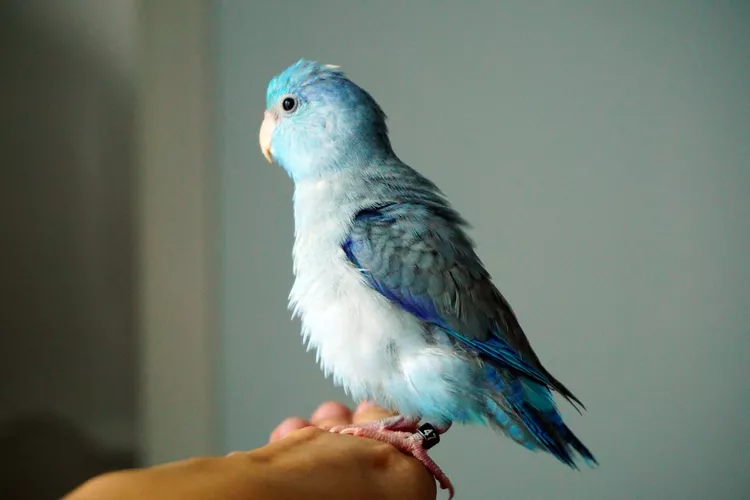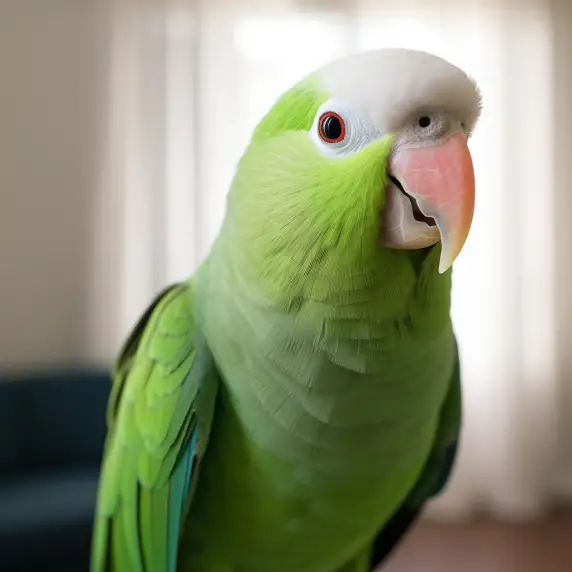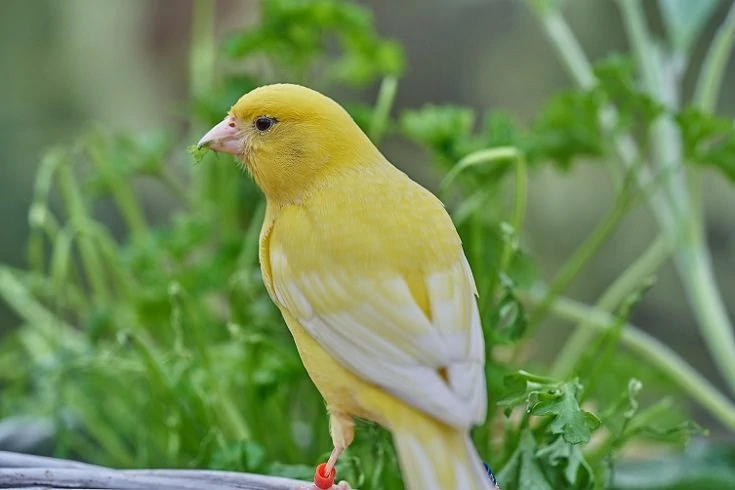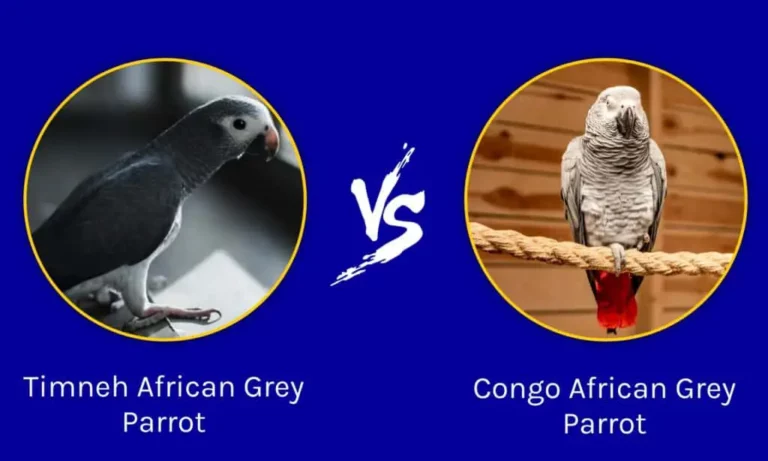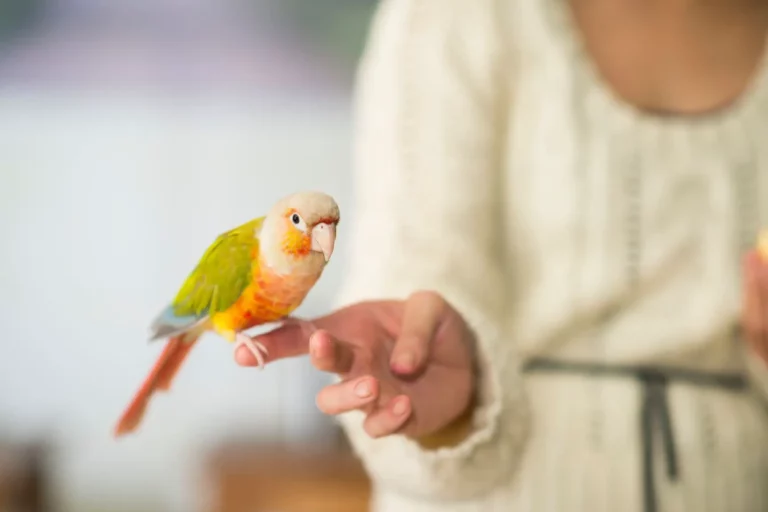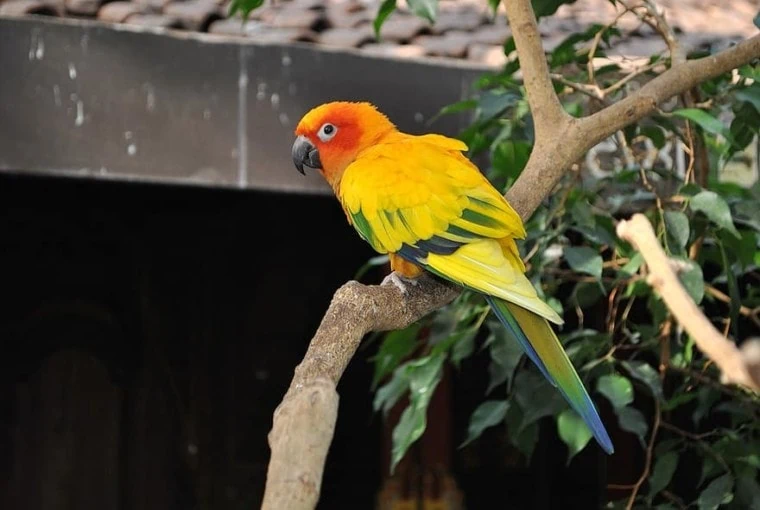10 of the Most Colorful Exotic Pet Birds You Can Own
Exotic pet birds captivate people with their striking colors, intriguing personalities, and unique behaviors. Their beauty and charm make them popular choices for those who want a feathered companion with a touch of the extraordinary.
Owning an exotic pet bird comes with great responsibility, as each species has specific needs for diet, socialization, and environmental factors. It’s crucial to thoroughly understand their requirements to provide the best care and ensure a long, healthy life for these incredible creatures.
This blog post introduces 11 of the most colorful exotic pet birds you can own, highlighting their distinctive features, behaviors, and care requirements. Explore these captivating species to find the perfect vibrant addition to your home and prepare to embark on a rewarding journey as an exotic bird owner.
Key takeaways
Sun Conures: Bright and sociable.
Eclectus Parrots: Males green, females red.
Indian Ringneck Parakeets: Brightly colored, males have neck ring.
Rainbow Lorikeet: Multicolored, active and playful.
Gouldian Finch: Kaleidoscope of colors and patterns.
Scarlet Macaw: Red, bright blue, yellow and some greens.
Hyacinth Macaw: Largest parrot, blue color.
African Grey Parrot: Active talker.
Crimson Rosella: Striking coloration.
Blue-Throated Conure: Attractive coloration of bright greens, blue and red.
10 of the Most Colorful Exotic Pet Birds You Can Own
1) Sun Conure
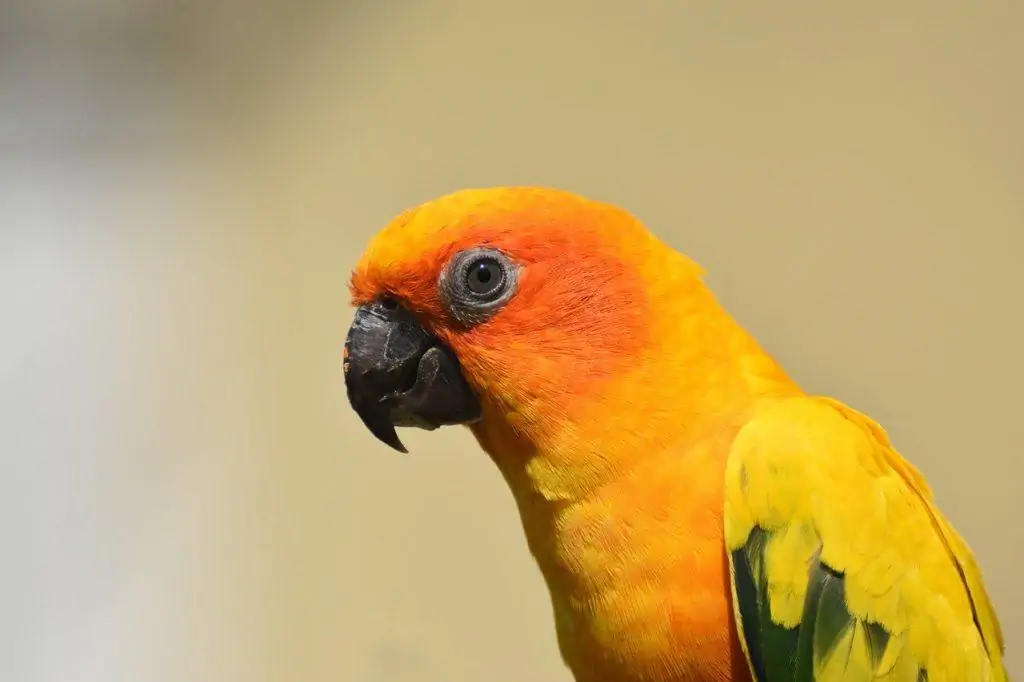
The Sun Conure is a small to medium-sized parrot known for its bright, eye-catching coloration. With vibrant hues of orange, yellow, green, and blue, these stunning birds are sure to make a striking visual statement in any household.
Sun Conures are renowned for their outgoing and playful personalities. They are social creatures that form strong bonds with their owners, often seeking attention and affection. Their inquisitive nature and intelligence make them eager learners, making training and interaction both fun and rewarding for owners.
To keep a Sun Conure happy and healthy, owners should provide a spacious cage with plenty of toys and perches for exercise and mental stimulation. A well-balanced diet consisting of pellets, fruits, vegetables, and occasional treats is essential for their well-being. Additionally, regular social interaction is crucial for these birds, as they thrive on companionship and can become stressed or lonely if left alone for extended periods.
2) Eclectus Parrot
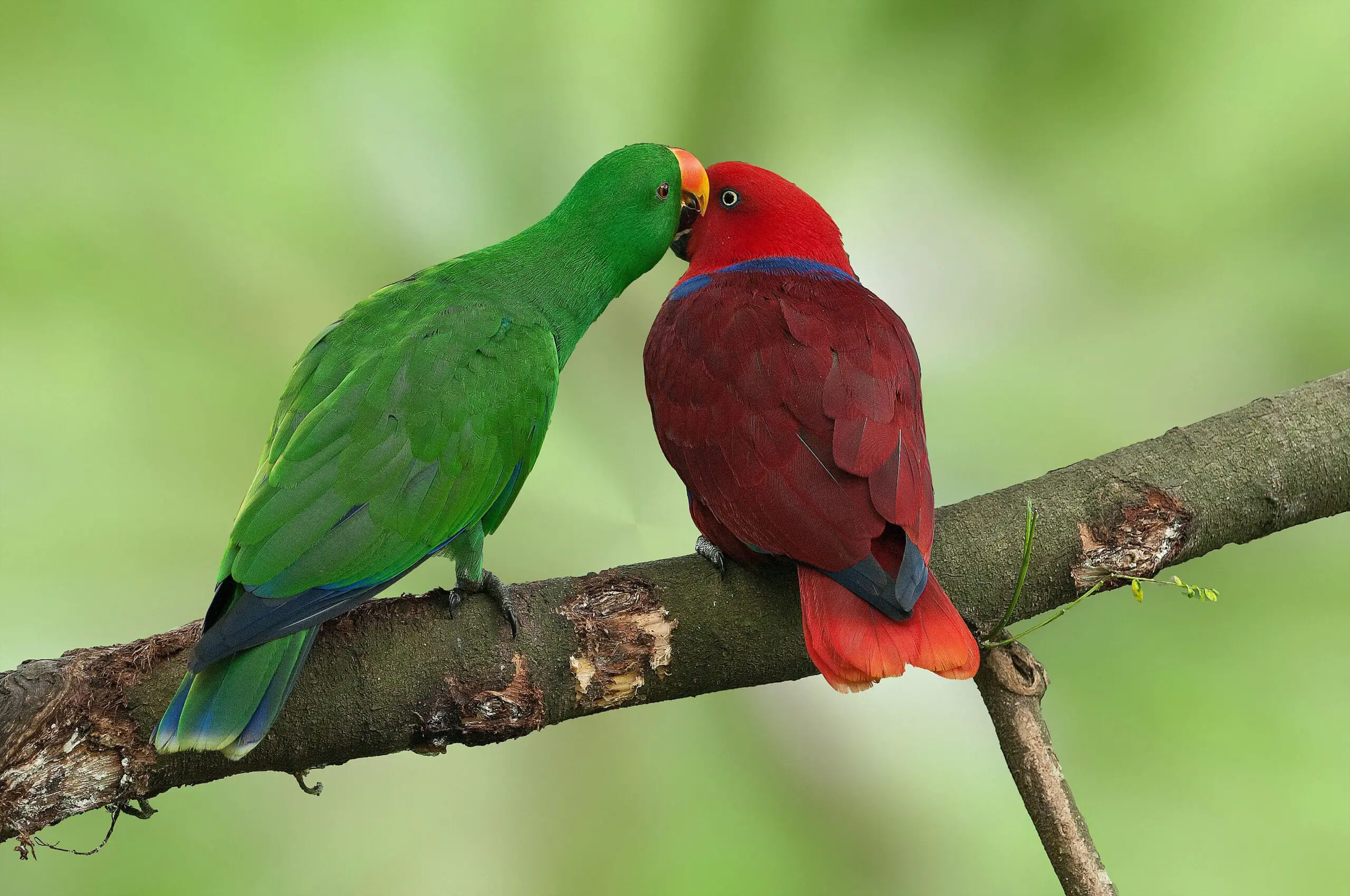
The Eclectus Parrot is a medium-sized parrot species that is remarkable for its striking sexual dimorphism in coloration. Males boast a rich green plumage with blue and red accents, while females are predominantly bright red with deep purple and blue highlights. This stark contrast makes them one of the most visually striking parrots in the world.
Eclectus Parrots are highly intelligent and possess exceptional talking abilities, often mimicking human speech with remarkable clarity. They are curious and gentle, which makes them delightful companions. However, they may also be more reserved than other parrot species, so patience and understanding are key when building a relationship with these sensitive birds.
An Eclectus Parrot’s diet is an important aspect of their care, as they have specific nutritional needs. A diet consisting mainly of fruits, vegetables, and a moderate amount of pellets is recommended, along with nuts and seeds as occasional treats. Providing a spacious, clean, and well-ventilated living space with various toys and perches for mental and physical enrichment is essential to keep them happy and healthy.
3) Indian Ringneck Parakeet
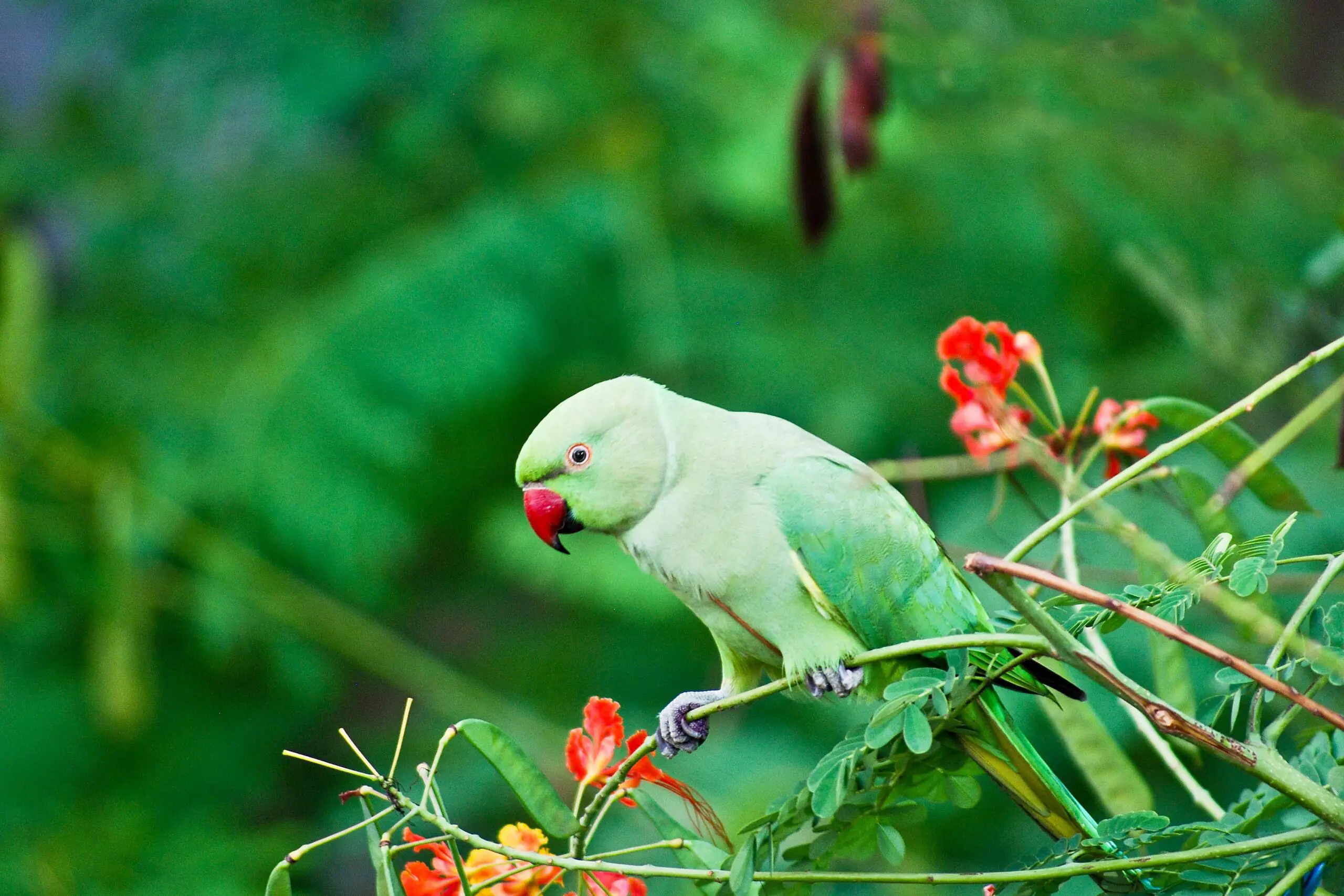
The Indian Ringneck Parakeet, also known as the Rose-Ringed Parakeet, is a medium-sized parrot with a long, elegant tail. Their vibrant coloration, which ranges from bright green to shades of blue, yellow, and grey, is complemented by a unique dark ring around the neck of adult males, giving them their name.
These parakeets are known for their playful and intelligent nature, making them excellent pets for those who appreciate an interactive and engaging companion. They can learn to mimic human speech and are quite adept at picking up new words and phrases. With proper socialization and training, they can become very friendly and attached to their owners.
To properly care for an Indian Ringneck Parakeet, provide a spacious cage with a variety of perches and toys to keep them mentally and physically stimulated. A well-balanced diet of pellets, fresh fruits, vegetables, and the occasional treat will keep them healthy. Regular interaction and training sessions will help build trust and strengthen the bond between you and your feathered friend.
4) Rainbow Lorikeet
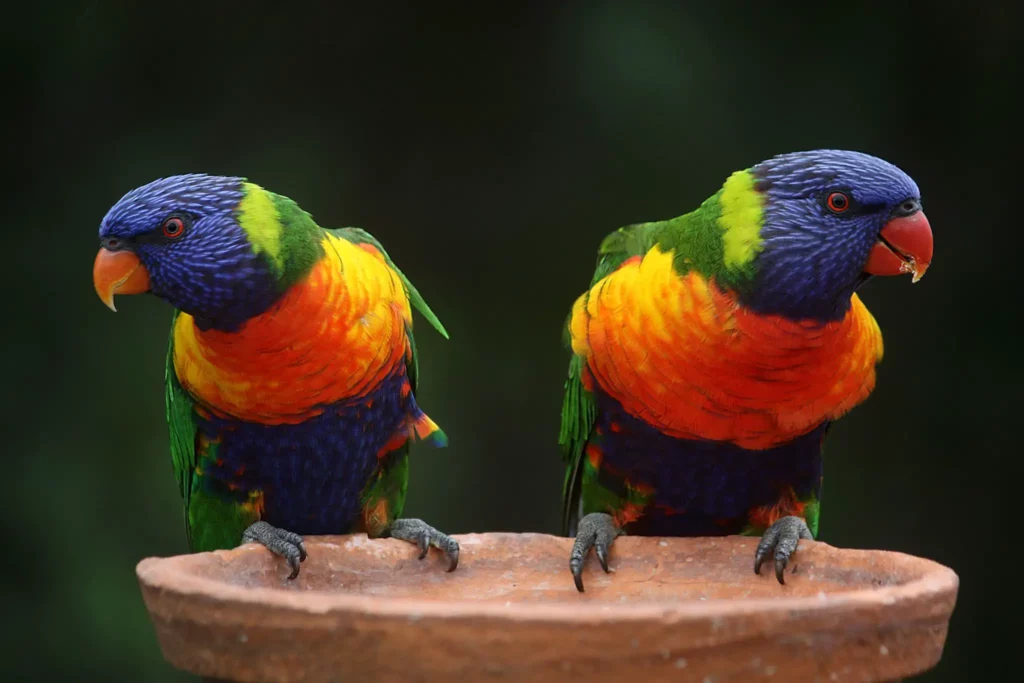
The Rainbow Lorikeet is a small to medium-sized parrot native to Australia and Indonesia, instantly recognizable by its stunning, vibrant rainbow-colored plumage. These vivacious birds exhibit a mix of bright blue, green, orange, yellow, and red feathers, making them truly unique and visually captivating pets.
Rainbow Lorikeets are social, active, and noisy birds that love to play and interact with their owners. They are known for their acrobatic antics and can often be seen hanging upside down or swinging from perches. Their friendly and inquisitive nature makes them delightful pets for those who enjoy lively, energetic companions.
Due to their specialized dietary needs, Rainbow Lorikeets require a nectar-based diet, which can be provided through commercial nectar mixes or homemade blends of fresh fruits and vegetables. They also enjoy occasional treats such as seeds and insects. A spacious cage with various perches and toys, as well as regular opportunities for exercise and social interaction, is crucial for their well-being. Keep in mind that their unique diet can result in messy droppings, so be prepared for regular cleaning and maintenance to ensure a hygienic environment.
5) Gouldian Finch
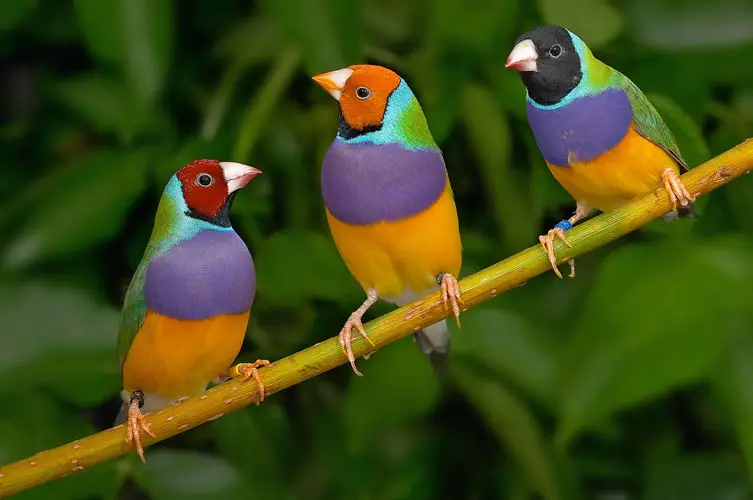
The Gouldian Finch, native to Australia, is a small, brilliantly colored bird that boasts a kaleidoscope of colors and patterns. With vivid shades of green, blue, purple, yellow, and red, these tiny birds are like living jewels, adding a touch of vibrant beauty to any home.
Gouldian Finches are social creatures, but they prefer a peaceful and quiet environment. They may be better suited for bird enthusiasts who appreciate their beauty from a distance rather than those seeking hands-on interaction. These finches are also known for their complex social behaviors and interesting mating rituals, making them fascinating subjects for observation.
To care for Gouldian Finches, provide a spacious, well-ventilated cage with plenty of perches and a few hiding spots to help them feel secure. A balanced diet consisting of high-quality seed mixes, supplemented with fresh fruits, vegetables, and the occasional insect, is essential for their health. As these finches are prone to stress, ensure their living environment is calm, quiet, and free of sudden disturbances.
6) Scarlet Macaw
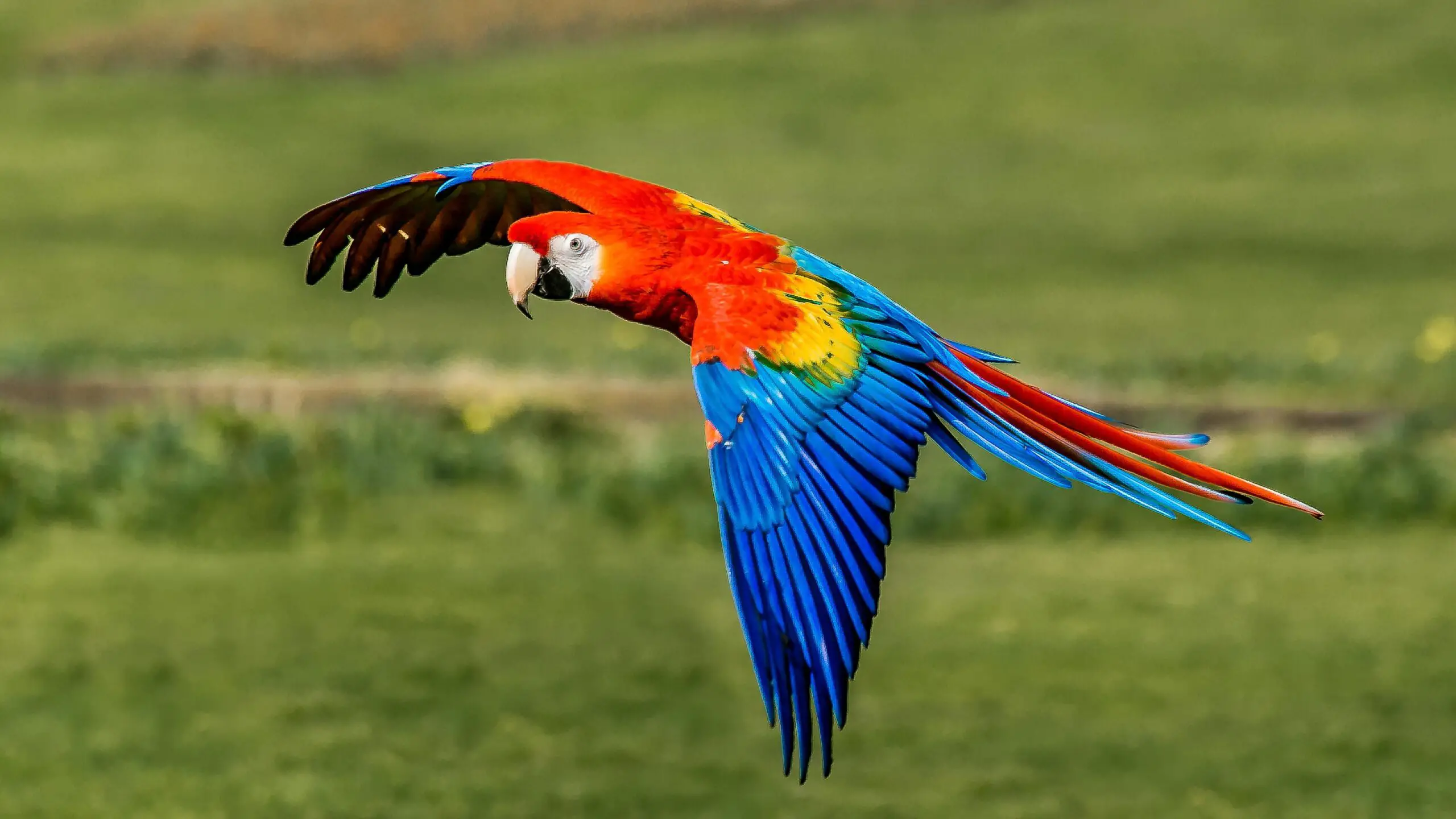
The Scarlet Macaw is a large, stunning parrot native to Central and South America. Their bold coloration, featuring vibrant shades of red, blue, and yellow, coupled with their impressive size and long tail, make them one of the most majestic and visually striking pet birds one can own.
Known for their strong personalities and high energy levels, Scarlet Macaws require owners who can provide plenty of attention and interaction. They are intelligent and affectionate, often forming deep bonds with their human companions. With proper socialization and training, they can learn tricks and become exceptional talkers.
To care for a Scarlet Macaw, a large, sturdy cage is necessary to accommodate their size and strength. Plenty of perches and toys should be provided for physical and mental enrichment. A well-balanced diet consisting of pellets, fresh fruits, vegetables, and occasional nuts is crucial for their health. As they are highly active and social birds, daily interaction, exercise, and opportunities to explore outside their cage are essential for their well-being.
7) Hyacinth Macaw
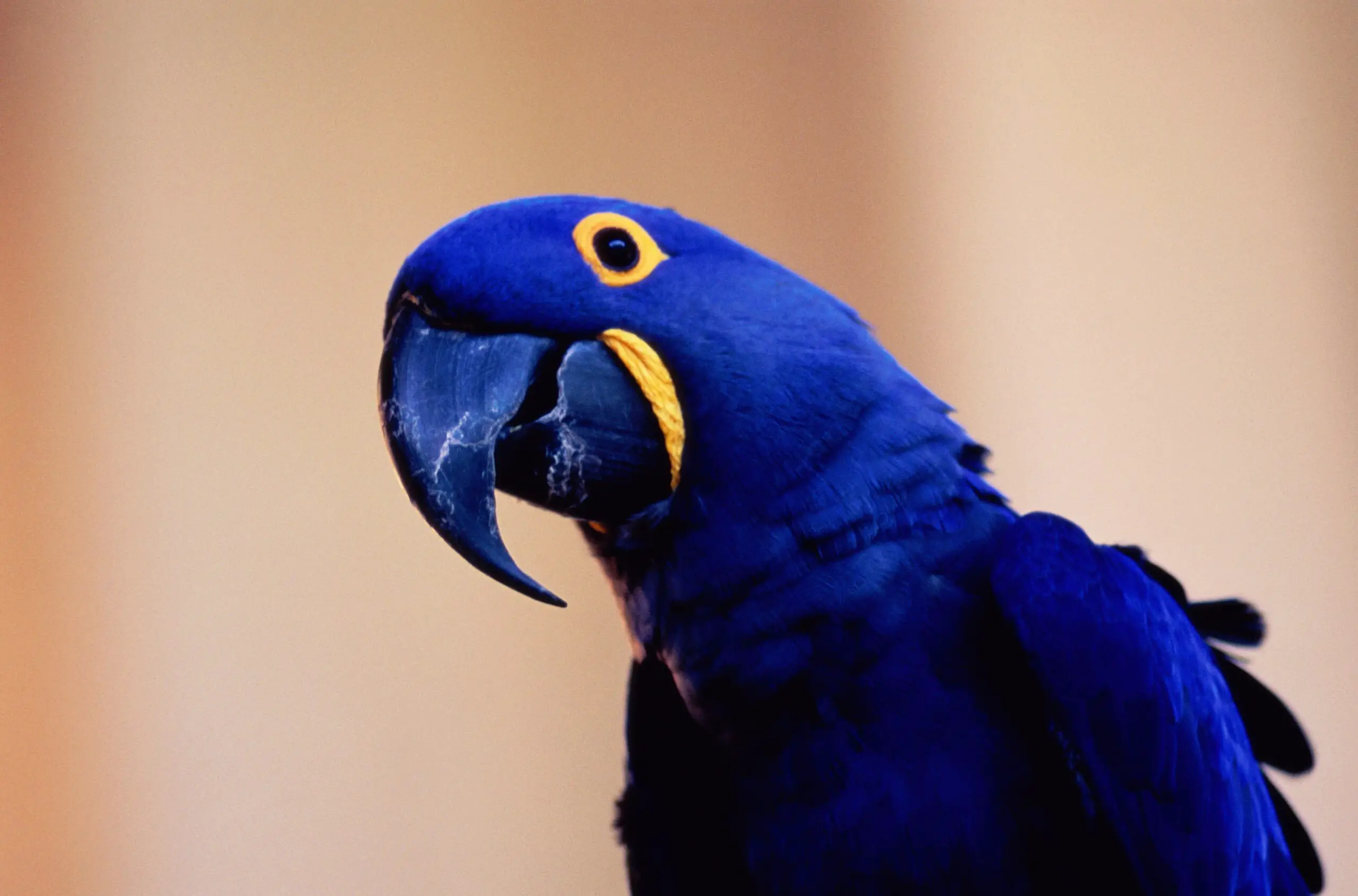
The Hyacinth Macaw is the largest of all parrots, reaching lengths of up to 40 inches from head to tail. Native to South America, these magnificent birds boast an impressive deep blue plumage and bright yellow accents around their eyes and beak, making them an awe-inspiring sight.
Despite their imposing size, Hyacinth Macaws are known for their gentle and affectionate demeanor. They are intelligent and inquisitive, quickly forming strong bonds with their owners. Their playful nature and sociable personalities make them wonderful companions for those who can provide the proper care and attention.
Caring for a Hyacinth Macaw requires a spacious and sturdy cage, as well as ample room to exercise and explore outside the cage. Their diet should consist mainly of nuts, particularly Brazil nuts and macadamia nuts, supplemented with fresh fruits and vegetables.
Eegular social interaction, mental stimulation through toys and puzzles, and opportunities for exercise are crucial for their well-being. Keep in mind that their powerful beaks can be destructive, so providing suitable toys for chewing and shredding is essential to prevent damage to household items.
8) African Grey Parrot
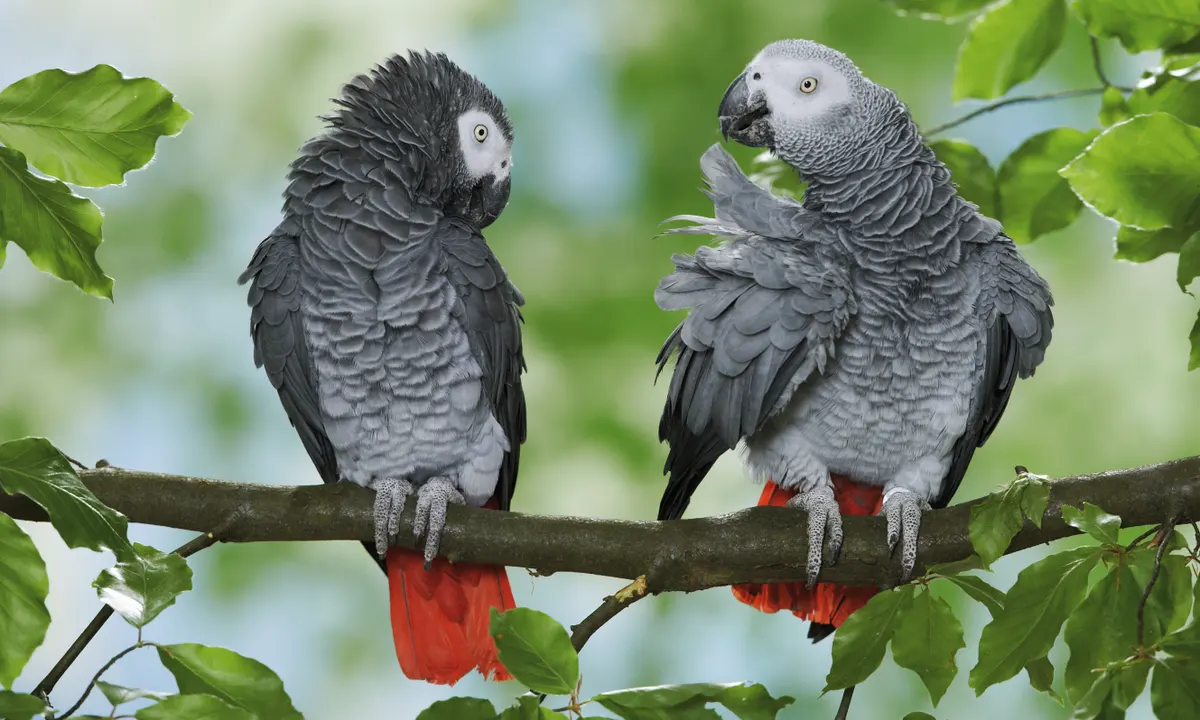
African Grey Parrots are medium-sized birds with an understated beauty, featuring a predominantly grey plumage and a striking red tail. Native to West and Central Africa, these parrots are renowned for their high intelligence and exceptional ability to mimic speech, making them one of the most popular exotic pet birds in the world.
Along with their remarkable cognitive abilities, African Greys have complex social and emotional needs. They require consistent attention, affection, and mental stimulation to thrive.
These sensitive birds can develop strong bonds with their owners, but they may also become prone to anxiety and stress if not properly socialized and cared for.
To provide optimal care for an African Grey Parrot, a spacious cage with plenty of perches, toys, and hiding spots is essential. Their diet should consist of high-quality pellets, fresh fruits, vegetables, and occasional nuts and seeds.
Regular interaction and mental stimulation, including puzzle toys and foraging activities, are crucial to keep them engaged and content. Monitoring their emotional well-being and providing a consistent, supportive environment is key to maintaining a happy and healthy African Grey.
9) Crimson Rosella
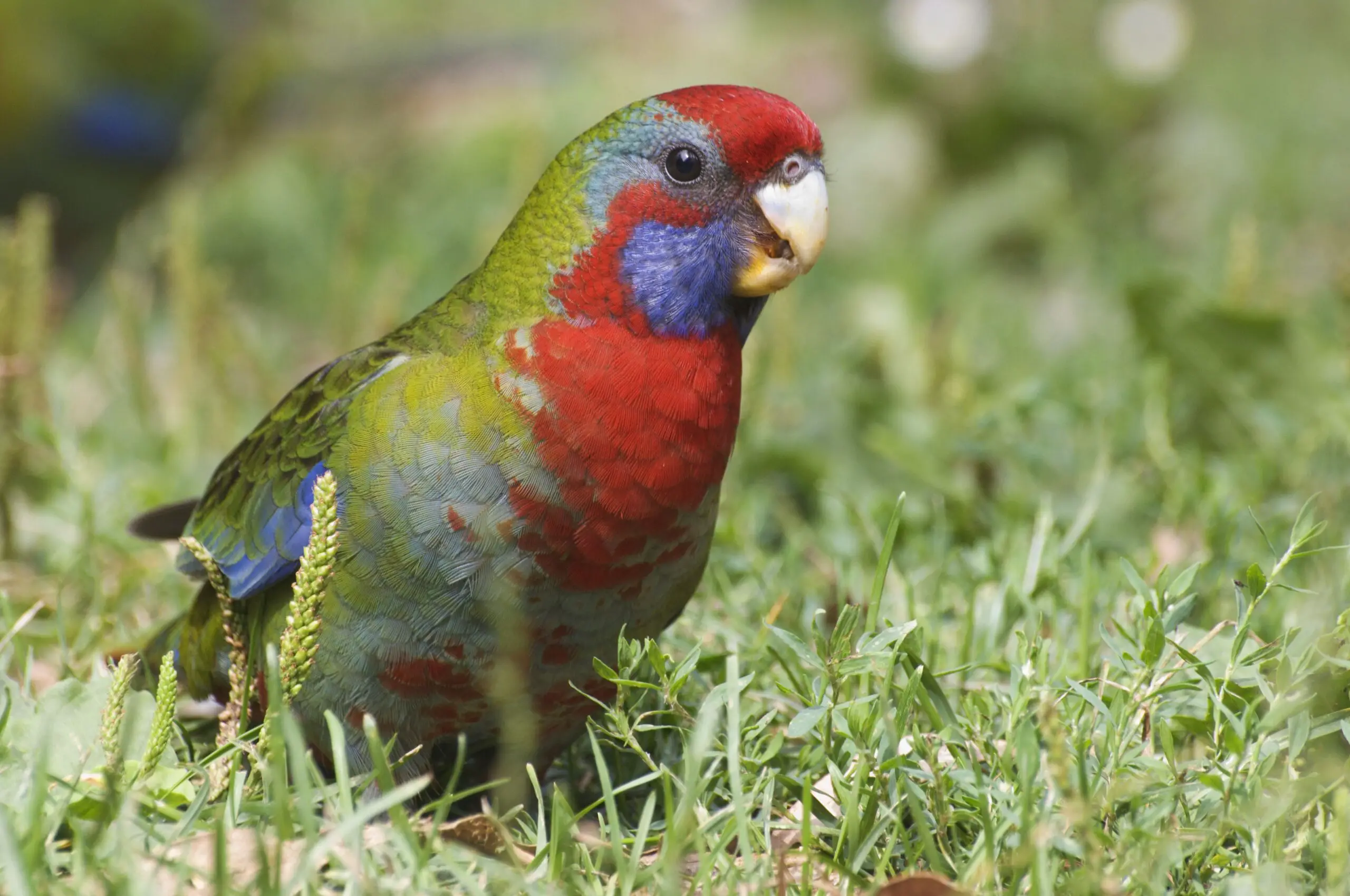
The Crimson Rosella is a medium-sized parrot native to eastern and southeastern Australia. Its striking coloration, featuring a vibrant red body with contrasting blue and black accents on the wings and tail, make it a visually stunning choice for an exotic pet bird.
These beautiful birds are known for their social behaviors and can be quite gregarious when kept with other birds of the same species. However, they may not always get along with different species, so it is important to monitor their interactions if they share their living space with other birds.
With patience and consistent training, Crimson Rosellas can become more comfortable around humans and may even learn to mimic speech.
To care for a Crimson Rosella, provide a spacious cage with a variety of perches and toys for mental and physical stimulation. A well-balanced diet of pellets, fresh fruits, vegetables, and occasional seeds and nuts is essential for their health.
Regular social interaction, both with other birds and their human caretakers, is crucial for their well-being. Be prepared to invest time and patience in building trust and forming a bond with your Crimson Rosella.
10) Blue-Throated Conure
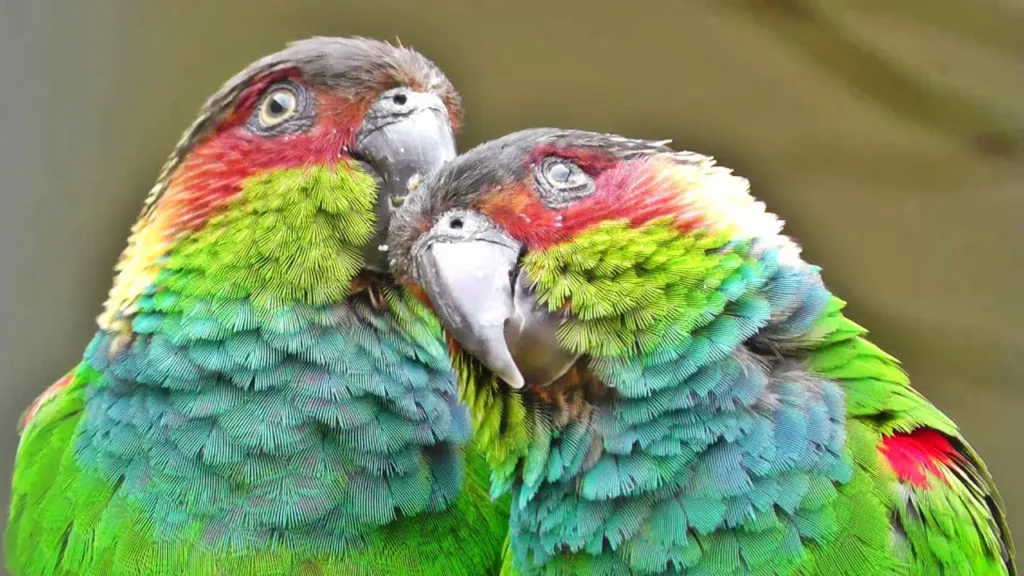
The Blue-Throated Conure is a small parrot native to South America, primarily found in the forests of Brazil and Bolivia. Their attractive coloration includes a bright green body, a blue patch on the throat, and red highlights on the tail, making them a visually appealing option for an exotic pet bird.
Blue-Throated Conures are known for their friendly and affectionate nature. They enjoy spending time with their human caretakers and are known to be less noisy than some other conure species. They may not be the best talkers, but with consistent training, they can learn to mimic some sounds and even perform tricks.
To care for a Blue-Throated Conure, provide a spacious cage with a variety of perches and toys for mental and physical stimulation. A well-balanced diet of pellets, fresh fruits, vegetables, and occasional seeds and nuts is essential for their health.
Regular social interaction and daily opportunities to explore outside their cage will keep them happy and engaged. With proper care and attention, the Blue-Throated Conure can be a delightful addition to any household looking for a colorful, loving pet bird.
Frequently Asked Questions
Are all of these exotic pet birds suitable for beginners?
Some of the birds listed, such as the Indian Ringneck Parakeet and Gouldian Finch, may be more suitable for beginners due to their relatively low maintenance needs. However, others like the Hyacinth Macaw and African Grey Parrot require more experience and knowledge about their care.
How long do these exotic birds typically live?
Lifespan varies significantly depending on the species. For example, Gouldian Finches can live up to 8 years, while larger parrots such as the Scarlet Macaw and Hyacinth Macaw may live for more than 50 years.
Can any of these birds be housed together with other bird species?
While some birds, like the Indian Ringneck Parakeet or Gouldian Finch, may coexist with other birds, it’s essential to research the compatibility of different species and monitor their interactions closely to ensure a safe and harmonious environment.
Are there legal restrictions on owning any of these exotic birds?
Some countries or states may have restrictions on owning certain exotic bird species or require permits. Always check your local laws and regulations before acquiring a new pet bird.
How can I find a reputable breeder or rescue for one of these exotic pet birds?
To find a reputable breeder or rescue, start by searching for local or national bird clubs, avian veterinarians, or online forums dedicated to exotic bird enthusiasts. These resources can help you find recommendations for trustworthy breeders and rescues in your area.
Additionally, always visit the breeder or rescue in person to assess the living conditions and health of the birds before making a commitment.
Conclusion
Owning a colorful exotic pet bird can be a rewarding and fulfilling experience, bringing joy and beauty to your life. Each of the 10 species mentioned in this blog post offers a unique combination of stunning plumage, engaging personalities, and captivating behaviors that make them truly exceptional pets.
Before committing to one of these exotic birds, it is essential to thoroughly research their specific care requirements, including diet, housing, and social needs. Providing an appropriate environment, consistent attention, and a loving home will ensure a long, happy life for your vibrant feathered companion.
No matter which of these exotic birds you choose, you can look forward to forming a special bond and creating cherished memories with your colorful new friend. Enjoy the journey and embrace the fascinating world of exotic pet birds!

